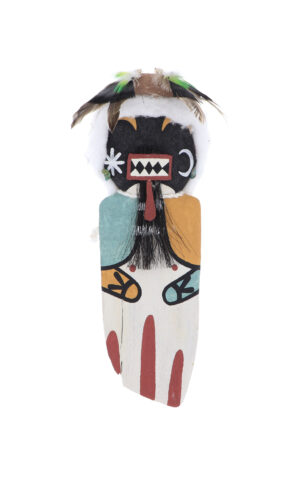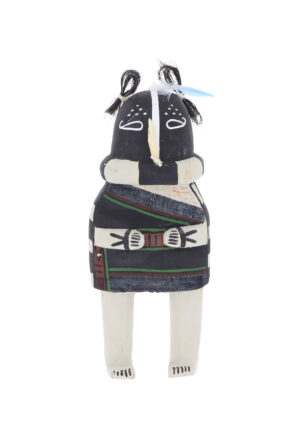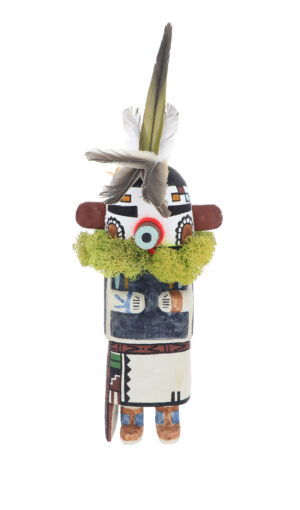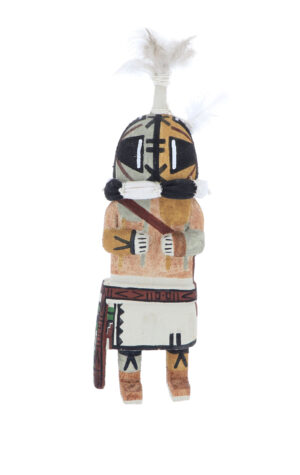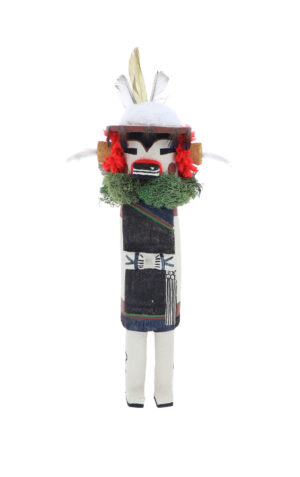Kachina Dolls & Carvings
The Native American Kachina dolls that we think of today are finely detailed woodcarvings depicting Hopi dolls and other Pueblo deities and sacred dancers. The Native American Indian Artisans of the Hopi Pueblo are known for their fine pueblo pottery and beautiful Indian baskets but as to the art of Kachina carving, only the Hopi have made the Kachinas into the art form it is today. “Kachina” is a Hopi word with many meanings and is probably best defined as ‘sacred’ but it also describes the masked dancers of the Hopi acting as spirit messengers at ceremonies during certain parts of the year. They perform the sacred rites of the kiva and bring blessings upon the Hopi people.
Filters
Color
Color (Basic)
Flavor
Length
Ring Size
Size
Holster Side
Rug Size
Shop For
Stone
Tribe
Artist
Price
Kachina Dolls History
History tells us the first Kachina dolls were not the elaborate carvings of today, but were simple flat dolls painted to accurately depict the deities they represented as a teaching tool for the children. They are still used for this purpose, but in the last century these Hopi dolls has evolved into its own Native American art form exemplified by fine detail and craftsmanship in the carving and motion of the subject. The Hopi have opened the trail of fine wood carving for other tribes such as the Navajo whose woodcarvings are also represented here. Traditionally, Kachina’s have been a less expensive alternative to the Hopi doll, using cloth, fur, and feathers as a substitute for the full wood carving. These dolls are still available and are an affordable alternative, but there are now a handful of Navajo carvers doing all wood carvings of antique dolls as well as representations from Hopi religion and ceremony. These carvings are finely crafted and as valuable as some of the finest Hopi antique dolls, but only a Hopi doll, hand carved in cottonwood root, can be called a true Kachina.
Hopi Kachina Dolls
Hopi Kachina dolls are traditionally carved from the roots of cottonwood trees, which once were abundant on the Hopi lands. Hopi use the word Paako for cottonwood, and it means water wood. The cottonwood root’s ability to seek and find a vast amount of water coincides with the ability of the katsinam to do the same for the Hopi people. The Hopi are communal farming people who reside on and near three mesas in northeastern Arizona. More than nine thousand Hopi live on a 1.5 million-acre reservation that encompasses a dozen villages.
Outsiders have long used the word kachina, to refer to all spiritual beings connected to Hopi religious life and the dolls that depict them. However, according to Hopi, katsina is the correct term and is preferred, as the plural of katsina is katsinam in the Hopi language.
The first known Kachina doll was obtained by traders in the year 1857. From there, they were picked up here and there until about the end of the 19th century. When it came to the style of these original dolls, very little is known, except that they were simple in style, with slightly detailed masks and simplified bodies.
Navajo Kachina Dolls
The Navajo Kachina dolls are crafted with care and are made to represent a variety of spirits and deities within the Navajo culture. The Navajo Kachina, or Katsina, dolls were originally created as trade commodities between the Navajo and nearby cultures. Though many were used in trade and selling, the Kachina were also kept by members of the Navajo tribe as decoration and praise.
The Navajo people create hundreds of Kachina dolls. The dolls can be crafted using various materials, including wood, cloth, sticks, stones, paint, feathers, and more. The dolls are created to represent a spirit or deity from the Navajo religion, with each representing a meaning or purpose.
Navajo Kachina dolls are a great gift to celebrate an accomplishment such as a graduation, a wedding, or birthday. Shop our selection of Navajo Kachina dolls and find one that fits you.
What are Kachina Dolls Made of?
Kachina Dolls are made differently then other Native American Dolls. Kachina Dolls are commonly made with cottonwood root thanks to it’s sturdiness and accessibility. On rare occasions Tupelo, a swamp wood is used instead. After the carving is completed kaolin clay is used to whiten and smooth the wood. This prepares the wood for decoration. The dolls are painted and brought to life with water colors or tempura but in the past vegetable dyes and native mineral coloring was used.

